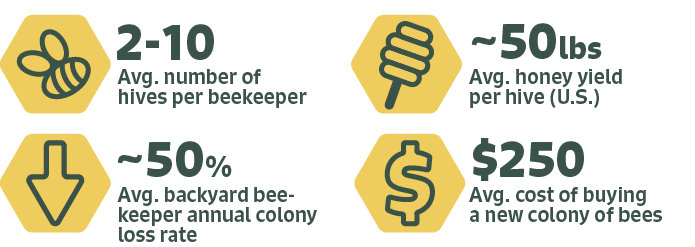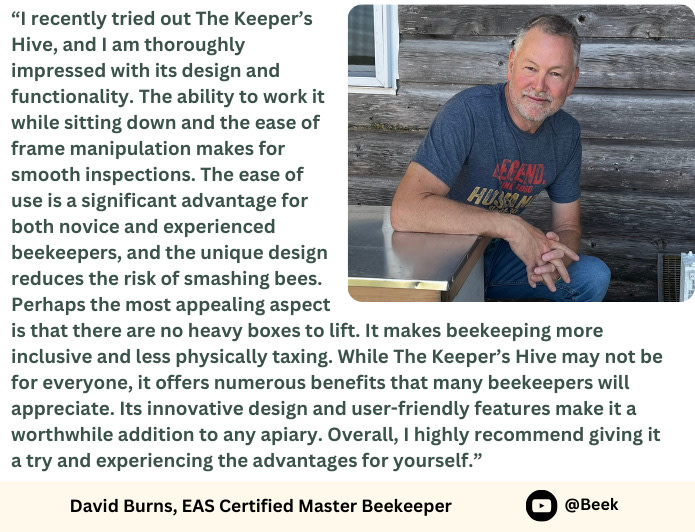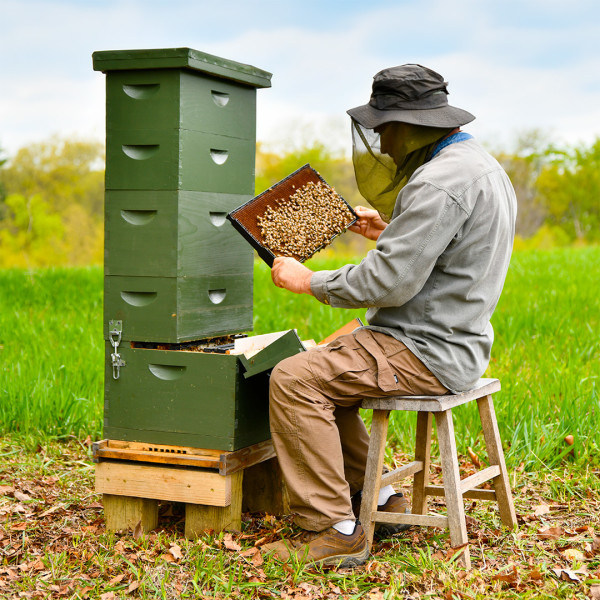
The world’s first Langstroth-style hive that you can inspect sitting down without lifting any boxes.


We didn’t try to reinvent the wheel, we just greased it a little.
The Langstroth hive is the most widely used beehive in the world because it’s simple, inexpensive, and can produce a lot of honey… but it also makes for a lot of hard work.
Beekeepers need to perform regular hive inspections to ensure that their bees survive and thrive. With Langstroth hives, that means having to repeatedly lift several boxes per hive that can weigh between 30 and 80 pounds. Not only does this disturb the entire colony of bees, but it can also discourage many beekeepers from performing management tasks at an optimal frequency.

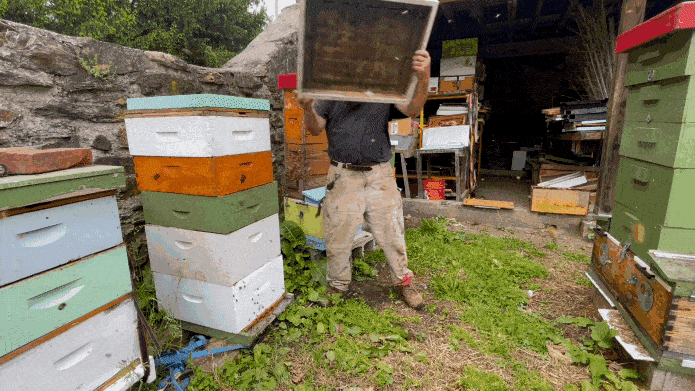


Easier management with less colony disruption means happier, healthier bees.
With some simple tweaks to the Langstroth design, The Keeper’s Hive allows beekeepers to access the brood chamber (the area that needs to be inspected at the bottom of the hive) without needing to lift a single box. In fact, you can even do it sitting down. This streamlines nearly every aspect of colony management, from mite checks to emergency feeding and swarm prevention.
There are many types of beehives in use all over the world – including some that don’t require heavy lifting – and we think ALL of them are awesome! But while they each have their unique advantages, many of them are not as portable, modular, scalable, or affordable as the Langstroth hive. We knew that if we could figure out a way to make Langstroth more user friendly it would be a win for beekeepers and their bees.
HOW WE DID IT
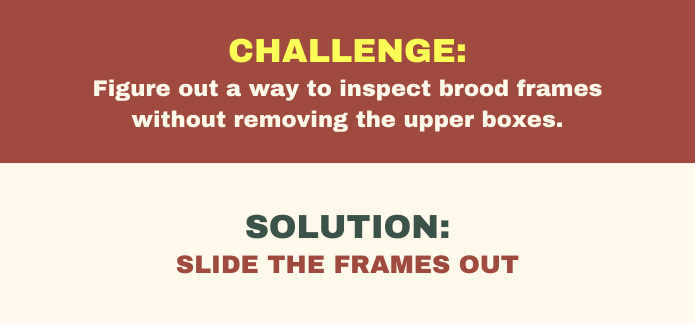
Well, if you’ve ever removed a frame from a beehive you know how crazy that sounds.
Bees create propolis, sometimes called “bee glue”, to seal the cracks in their hives. When they apply it to frames it makes them difficult to remove, let alone slide…

By completely blocking the bees from accessing the ends of the frames, we are able to prevent propolis from building up so that all of the frames and components can be easily removed. Thanks to our patented design, frames are actually easier to remove from The Keeper’s Hive than from a traditional Langstroth hive.

WHY WE DID IT
Beekeeping is not easy!
One of the reasons we designed this hive was to make beekeeping more accessible to people who have physical limitations or difficulty with heavy lifting. We’re willing to bet that 90% of beekeepers would say that heavy lifting is one of their least favorite aspects of beekeeping, and it’s not just a minor annoyance – it’s one of the reasons that many eventually give up their hobby and a reason why others never start. An estimated 70-80% of new beekeepers quit after the first couple of years, usually because it’s more work than they expected and their bees keep dying.
Most beekeepers are hobbyists with a few hives who just want to keep their bees alive and make honey for their friends and family.
Even very experienced beekeepers do not have perfect success rates and have to confront unique challenges on an ongoing basis. Changing weather patterns and the spread of disease from the invasive mite Varroa destructor have made beekeeping far more challenging than it was just a couple of generations ago.
For the average beekeeper, their best chance at keeping their bees alive comes down to one thing: colony management. With The Keeper’s Hive, it’s easier than ever before.
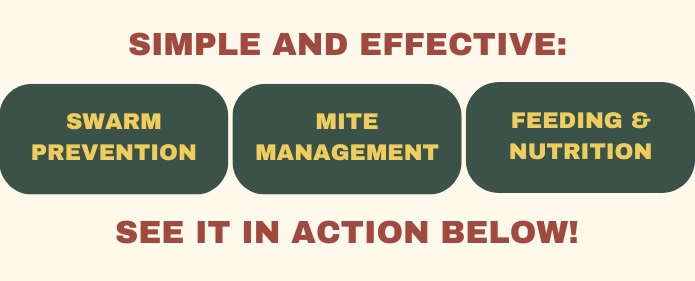
WHAT OTHER KEEPERS ARE SAYING
We’ve been laying pretty low and developing our products for the past 8 years, but we decided it was time to start putting ourselves out there…

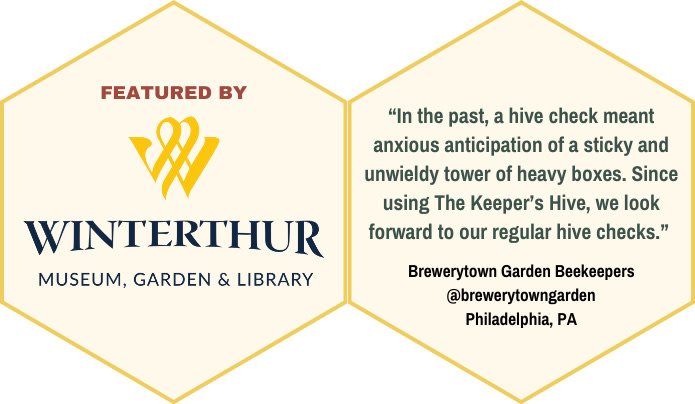
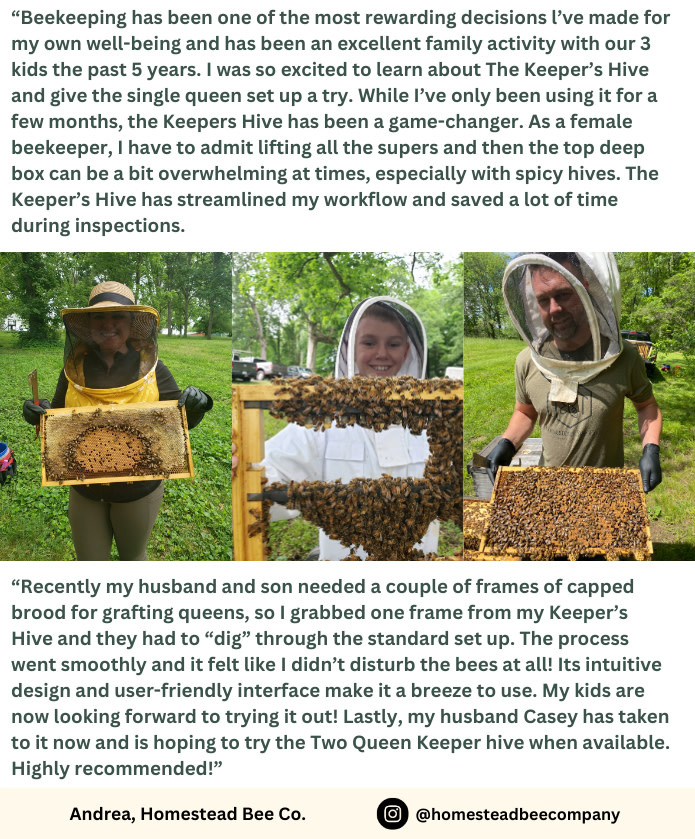
WHY WE NEED YOUR HELP
Our goal is simple: to make this hive available to any beekeeper that wants to try it, anywhere in the world.
Whether you’re a seasoned bee whisperer, just getting started, or you want to help us make this hive available to beekeepers everywhere, your support goes a long way. The money we raise will go toward startup costs, manufacturing, and expanding distribution to outside of the U.S. as soon as possible.
Your contributions have a direct impact on our ability to make an impact!

DETAILS AND SPECIFICATIONS
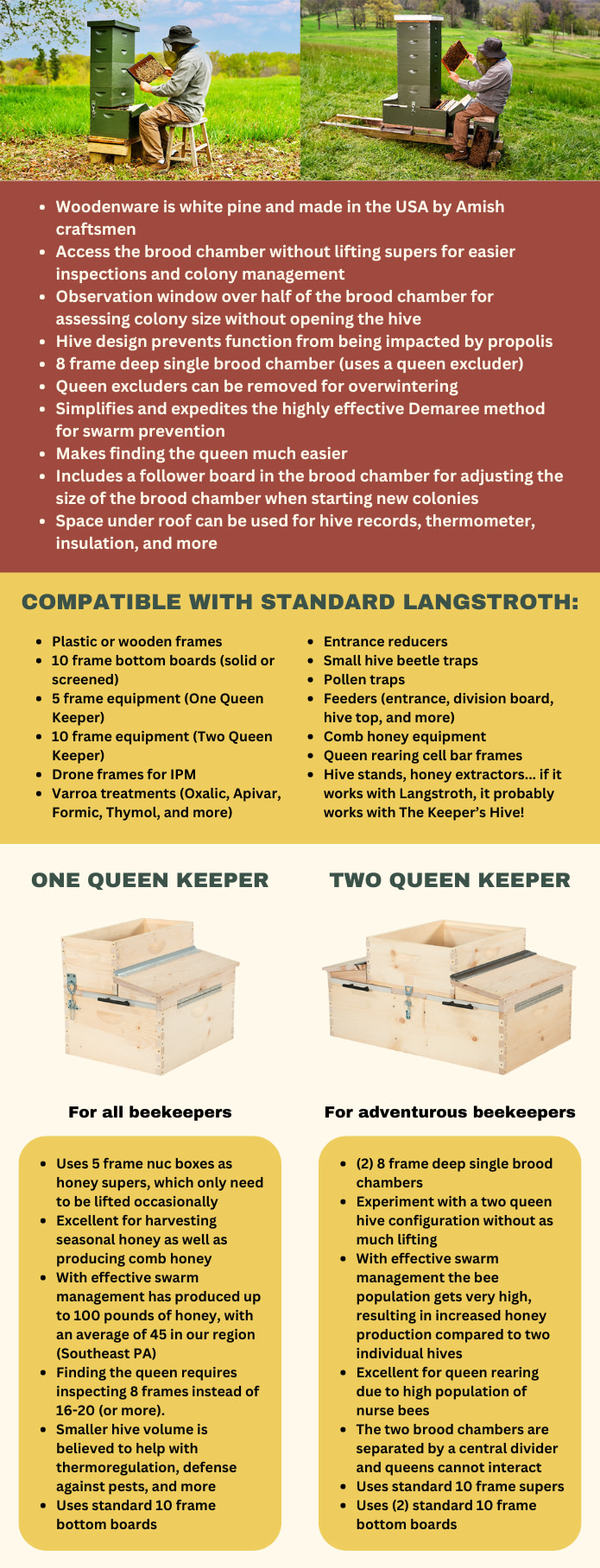
THE KEEPERS BEHIND THE HIVE
COMMON CONCERNS
We have lots of additional information about our hives and their management on our website and YouTube channel:
https://www.youtube.com/@TheKeepersHive
Field Testing
Many prototypes of both the One Queen Keeper and Two Queen Keeper have been field tested in Southeastern Pennsylvania (Zone 6b) by dozens of beekeepers over the past 8 years. The current versions of the hives have been in the field for ~3 seasons and are holding up great (we have many videos of these hives in use on our YouTube channel). Depending on how Langstroth hives are managed in your specific location, you may need to adapt some of those management strategies to The Keeper’s Hive.
Single Brood Chamber Management
We recognize that single brood chamber management may be new to many people. There are many educational resources on single brood chamber management available online, as well as information on the benefits of this approach. The design of The Keeper’s Hive helps address many of the drawbacks of single brood chamber management with traditional Langstroth hives, but ultimately we want everyone to go with whatever management style best suits their beekeeping goals.
Winterization/Insulation
We have detailed information about overwintering colonies in The Keeper’s Hive on our website and YouTube channel. The process is very similar to a standard Langstroth hive, and both hives can be reconfigured to prioritize honey stores and/or supplemental feed if necessary. We have not tested these hives in extreme winter climates, but there is excellent information available out there about how to overwinter single brood chamber colonies (and even nucs) using wooden hives in northern areas with harsh winters. Still, we plan to explore developing insulated versions of our hives in the future.
Hive Height/Wind/Animals
We recommend using a ratchet strap to secure your hives to help with stability, but we’ve never had problems with them falling over even in high winds. We also generally use shorter hive stands to make it easier to sit on a stool for inspections. If you have a highly productive colony and are concerned about the height of the honey supers, you have the option to harvest honey more frequently to keep the overall height of the hive lower.
Supers Pinching The Frame Guards
On the One Queen Keeper, we prevent the weight of the honey supers from “pinching” the frame guards between the queen excluder and frames with two adjustable hive clamps on the back of the hive. Honey supers on the Two Queen Keeper are evenly balanced on a center platform that can support their full weight.
Hive Volume/Swarming
In our view, smaller hives are a good thing: studies have shown that honey bees typically prefer nest cavities that are around 40 liters in volume, almost exactly the size of our 8 frame deep single brood chamber. The biggest management challenge with a smaller brood chamber is swarm prevention, but the easy brood chamber access of The Keeper’s Hive makes your preferred method of swarm prevention much less labor intensive to perform. We have had incredible success preventing swarms by using the Demaree method of swarm prevention, and have a guide for this approach on our website. There are also many other highly detailed resources on the principles of the Demaree method available online.
Honey Production/Commercial Beekeeping
The Keeper’s Hive was primarily designed with the backyard beekeeper in mind. Also remember that potential honey yields vary widely from location to location based on several variables. In our area, the One Queen Keeper has produced honey crops comparable to traditional Langstroth hives, it just requires more frequent harvesting due to the smaller space available for honey storage with nuc-sized supers. Conversely, the Two Queen Keeper has produced honey crops significantly higher than we usually see with two traditional Langstroth hives. Still, there are no guarantees in beekeeping and ultimately our hives are just tools that help make management easier – hopefully meaning better outcomes for you and your bees!
Two Queen Hive Management
Many people have asked us what is really going on inside the Two Queen Keeper, and aside from being able to say with confidence that 1) the queens are completely separated, and 2) the higher population of bees can potentially make a lot of honey and raise great queen cells, we honestly don’t really know. Beekeepers have been experimenting with two queen hive configurations for years, but they are not widely used and we like to say that they fall into the “cowboy” beekeeping category. One of the main issues with running two queen hives in the past is the number of boxes used and the amount of work required to perform colony management. We believe that the Two Queen Keeper is one of the most “manageable” two queen hives to date, and we’re excited for more people to give it a shot!
Varroa Mite Management
Thanks to having immediate access to the brood chamber, checking mite levels with The Keeper’s Hive is quick and easy. Similarly, treatments can be applied to the brood chamber without needing to deconstruct the hive. Nearly all varroa mite treatments that we have come across work with The Keeper’s Hive.
Small Hive Beetles
The smaller brood chamber and use of the follower board helps keep bees “wall to wall” in The Keeper’s Hive, which limits the ability of small hive beetles to run and hide. We have found that the bees are much better at defending their space when they are not trying to defend beeless frames.
Open Spaces In The Hives
There are no open spaces on either hive for pests to inhabit or access or for the bees to build comb in. The interior dimensions of the brood chambers on both hives perfectly match those of an 8 frame deep. On the Two Queen Keeper, the open space in the center between the brood chambers is completely walled off and cannot be accessed via the bottom boards.


